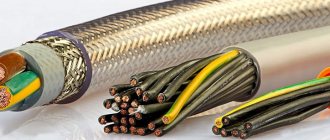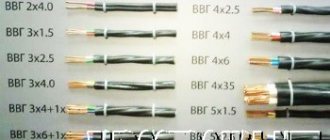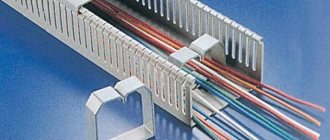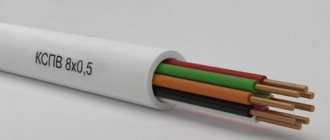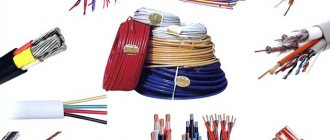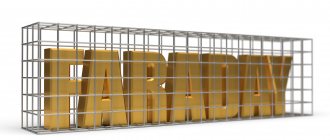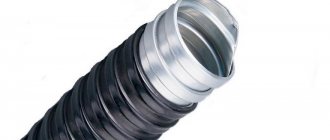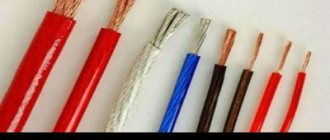What is rubber insulation made of?
The basic set of materials from which the rubber insulating layer and other coverings are produced traditionally includes:
- rubbers (natural or synthesized);
- fillers (talc, chalk, kaolin);
- softening components (paraffin or bitumen compounds, stearic, petroleum jelly);
- enhancers (soot);
- vulcanizers (sulfur).
Depending on the functional purpose of the cable and wire product, manufacturers can change the proportions of the components:
- rubbers - 25-60%;
- fillers - 35-70%;
- softeners - about 2%;
- vulcanizing agents - approximately 1.5%.
Developed special grades of rubber allow this type of material to work in difficult conditions, for example, when exposed to high voltage electric currents, in extreme temperature conditions, in an oil and fuel environment, under significant mechanical loads and UV radiation.
FLEXIBLE CABLES AND WIRE WITH RUBBER INSULATION FOR GENERAL PURPOSE
8.1. NOMENCLATURE
Rubber-insulated flexible general-purpose cables, produced in accordance with GOST 13497-77, are intended for connecting various mobile mechanisms with alternating voltage up to 660 V with a frequency of 50 Hz. The cables are designed for operation in various atmospheric conditions with a long-term permissible conductor temperature of no more than 65ºС. The list of brands of cables and wires is given in table. 8.1, and the assortment in table. 8.2.
To brands of cables KG, KGN, KPG, KPGS, KPGSN and KPGU, produced for use in areas with a tropical climate in accordance with GOST 15150-69, the T index is added, and to brands of cables KG, KPG, KPGSN and KPGU, intended for areas with cold climate, according to the same GOST - HL index.
In table 8.3 shows the composition of the nominal cross-sections of the grounding and control conductors depending on the main conductors of flexible general purpose cables. For export deliveries, other sections of grounding conductors are allowed.
Table 8.1. Range of flexible cables and wires with rubber insulation and general purpose sheath
| Brand (OKP code) | Cable | Preferred area of application |
| KG (3544410100) | With copper conductors, rubber insulated, rubber sheathed | For bends with a radius of at least 8 D and temperatures from –40 to +50ºС |
| KGN (3544410200) | The same in a rubber, oil-resistant, flame retardant shell | The same applies to conditions where the shell is exposed to disinfectants and aggressive substances used in agriculture, as well as oil at temperatures from -30 to +50ºС |
| CNG (3544410300) | Same as CG, but with increased flexibility | For bends with a radius of at least 5 D and temperatures from –50 to +50ºС |
| KPGN (3544411600) | Same as KGN, but with increased flexibility | The same applies to conditions where the shell is exposed to disinfectants and aggressive substances used in agriculture, as well as oil at temperatures from -30 to +50ºС |
| KPGS (3541450700) | Same as CNG, but with a profiled rubber core | When bending with a radius of at least 5 D when the cable is exposed to shock and crushing loads and temperatures from –50 to +50ºС |
| KPGSN (3544450800) | The same in a rubber, oil-resistant, flame retardant shell | The same applies to contact with the shell of disinfectants and aggressive substances used in agriculture, as well as oil at temperatures from -30 to +50ºС |
| KPGU (3544412700) | Same as CNG, but with increased flexibility cores and rubber filling between them | For bends with a radius of at least 10 D and temperatures from –50 to +50ºС |
| PRS (3555146000) | Flexible wire with twisted cores, rubber insulation in a rubber sheath | For connecting machines and devices to electrical networks of alternating voltage 220/380 V, frequency up to 400 Hz at temperatures from –40 to 65ºС |
| PRSU (3553546000) | The same in a rubber thickened shell | Same |
Table 8.2. Range of flexible cables and wires with rubber insulation for general purposes
| Brand | Number of cores | S, mm2 | ||
| main | grounding | management | ||
| KG and KGN | 1 | — | — | 2,5-120 |
| 2; 3 | — | — | 0,75-120 | |
| 2; 3 | 1 | — | 0,75-120 | |
| CNG | 2 | — | — | 0,75-70 |
| 2; 3 | 1 | — | 0,75-70 | |
| KPGN | 3 | 1 | — | 1,5-10 |
| 3 | 1 | 1 | 1,5-10 | |
| KPGS, KPGSN | 3 | 1 | — | 2,5-120 |
| 3 | 1 | 1 | 2,5-6 | |
| KPGS, KPGSN | 3 | 1 | 2 | 4-50 |
| KPGU | 3 | — | — | 95-150 |
| 3 | 1 | — | 95-150 | |
| PRS | 2; 3 | — | — | 0.5 and 1.5 |
| PRSU | 2 | — | — | 0,5 |
Table 8.3. Cross-sections of grounding and control conductors depending on the cross-section of the main conductors of flexible cables with rubber insulation for general purpose, mm2
| Main veins | Grounding conductors | Control cores |
| 0,75 | 0,75 | — |
| 1,0 | 1,0 | — |
| 1,5 | 1,0 | 1,5 |
| 2,5 | 1,5 | 1,5 |
| 4,0 | 2,5 | 2,5 |
| 6,0 | 4,0 | 4,0 |
| 10,0 | 6,0 | 6,0 |
| 16,0 | 6,0 | 6,0 |
| 25 | 10 | 10 |
| 35 | 10 | 10 |
| 50 | 16 | 10 |
| 70 | 25 | — |
| 95 | 35 | — |
| 120 | 35 | — |
| 150 | 50 | — |
| Note. In CPG and KPGN cables, the grounding conductors and auxiliary conductors have cross-sections equal to the sections of the main conductors, and in the KPGU cable, with a cross-section of the main conductor of 95 mm2, the cross-section of the grounding conductor should be 25 mm2 | ||
8.2. STRUCTURAL ELEMENTS OF CABLES AND WIRES
The conductors consist of copper wires in accordance with GOST 22483-77 according to the designs given in table. 8.4, but the use of cores with a large number of wires is allowed. Current-carrying conductors are insulated with rubber type RTI-1 with a thickness of 0.6 mm with a permissible deviation of 10%.
The main insulated cores have a distinctive color or other type of distinction. By agreement with the consumer, cables can be manufactured without colors or other types of differences in the cores. The grounding conductor, in addition to the grounding conductor of the KPGU cable, has a green-yellow color. For export delivery, the colors of the cores correspond to the table. 8.5.
The insulated main conductors, together with the grounding conductors and control conductors, are twisted in the right direction. Insulated cores of cables KPG, KPGN: three-core with a cross-section of 35 mm2 and more, four-wire with a cross-section of 4 mm2 and more, five-core of all sections, as well as cables KPGS and KPGSN with a cross-section up to 6 mm2 inclusive, are twisted around a round rubber core, and cables KPGS and KPGSN with a cross-section of 10 mm2 and more - around a profiled rubber core. The insulated cores of the KPGU cable (except for the cable with a two-layer sheath) are twisted with a filling of cable yarn or stapled glass yarn and wrapped with a tape of rubberized fabric or synthetic film. In four-core cables, it is allowed to twist the cores around a rubber profiled core.
The twisting steps of insulated cores do not exceed the values indicated in the table. 8.6. The twisted insulated cores of the KGN, KPGN, KPGSN cables are wrapped with a synthetic film strip and a rubber sheath of the RShN-1 type is applied; cables KPG, KPGS, KPGU - type RSh-1. Deviation from the nominal thickness is allowed up to – 20%. The insulated conductors of the PPC and PRSU wires are twisted and a rubber sheath of rubber type RShT-2 or RShTM-2 is placed on them according to OST 16.0.505.015-79. The values of the external diameters of the cables are given in table. 8.7.
The outer diameter of a two-core wire PRSU with a cross-section of 0.5 mm2 is 7.3 mm; three-core wire PRS with a cross-section of 0.5 mm2 - 6.6 mm;
Table 8.4. Design data of current-carrying cores of flexible cables with rubber insulation for general purposes
| S, mm2 | Cable core designs | |
| KG, KGN | KPG, KPGN, KPGS, KPGSN, KPGU | |
| 0,75 | 19*0,23 | 24*0.20 or 19*0.23 |
| 1,0 | 19*0,26 | 32*0.20 or 19*0.26 |
| 1,5 | 19*0,32 | 28*0.26 or 19*0.32 |
| 2,5 | 49*0,26 | 49*0,26 |
| 4,0 | 49*0,32 | 49*0,32 |
| 6,0 | 49*0,40 | 84*0,30 |
| 10 | 49*0,50 | 91*0,37 |
| 16 | 56*0,60 | 84*0,49 |
| 25 | 84*0,60 | 126*0,50 |
| 35 | 133*0,58 | 189*0,49 |
| 50 | 133*0,68 | 266*0,49 |
| 70 | 189*0,68 | 266*0,58 |
| 95 | 266*0,67 | 361*0,58 |
| 120 | 266*0,77 | 266*0,77 |
| 150 | — | 405*0,68 |
Table 8.5. Coloring of cores of flexible cables with rubber insulation for general purposes, supplied for export (cables with a grounding core)
| Number of cores | Core color |
| 3 | Green-yellow, blue, brown |
| 4 | Green-yellow, blue, black, brown |
| 5 | Green-yellow, blue, black, brown, black |
| 6 | Green-yellow, blue, black, brown, black, black |
| Note. Green-yellow insulation color is used only for the grounding conductor. | |
Table 8.6. Twisting pitch of insulated cores of flexible cables with rubber insulation for general purpose is no more than
| Brand | S, mm2 | Twist pitch |
| KG, KGN | 0,75-50 | 16 D |
| 70-120 | 14 D | |
| CNG, KPGN, KPGS, KPGSN | 0,75-50 | 12D |
| CNG, KPGS, KPGSN | 70-120 | 10D |
| KPGU | 95-150 | 14 D |
Table 8.7. External diameter, mm, of flexible cables for general purposes
| S, mm2 | KG, KGN | CNG, CPGN | KPGS, KPGSN | KPGU | |||||||||||
| One main core | Two main cores | Two main conductors and a ground conductor | Three main cores | Three main conductors and a ground conductor | Two main cores | Two main conductors and a ground conductor | Three main conductors and a ground conductor | Three main conductors, a grounding conductor and an auxiliary | Three main conductors and a ground conductor | Three main conductors, a grounding conductor and an auxiliary | Three main conductors, a grounding conductor and two auxiliary conductors | Three main cores | Three main conductors and a ground conductor | Two main cores | |
| 0,5 | — | — | — | — | — | — | — | — | — | — | — | — | — | — | 6,3 |
| 0,75 | — | 10,3 | 10,8 | 10,8 | 11,6 | 10,4 | 10,9 | 11,8 | — | — | — | — | — | — | — |
| 1,0 | — | 10,6 | 11,1 | 11,1 | 12,0 | 10,7 | 11,2 | 12,1 | — | — | — | — | — | — | — |
| 1,5 | — | 11,2 | 11,8 | 11,8 | 12,7 | 11,8 | 12,4 | 13,4 | 15,5 | — | — | — | — | — | 8,2 |
| 2,5 | 7,3 | 12,7 | 13,4 | 13,4 | 15,5 | 12,7 | 13,4 | 15,5 | 16,8 | 18,1 | 19,7 | — | — | — | — |
| 4,0 | 7,9 | 13,8 | 15,5 | 15,5 | 16,8 | 13,8 | 15,5 | 16,8 | 18,2 | 19,2 | 21,8 | 22,8 | — | — | — |
| 6,0 | 8,6 | 16,2 | 17,1 | 17,1 | 18,5 | 16,5 | 17,4 | 18,9 | 21,5 | 21,9 | 23,5 | 24,5 | — | — | — |
| 10 | 10,9 | 18,8 | 19,9 | 19,9 | 22,7 | 19,6 | 21,7 | 23,6 | 25,8 | 25,0 | — | 31,6 | — | — | — |
| 16 | 12,3 | 22,7 | 22,7 | 24,0 | 24,6 | 23,0 | 24,3 | 27,5 | — | 29,4 | — | 36,0 | — | — | — |
| 25 | 15,3 | 27,6 | 27,6 | 29,1 | 29,9 | 27,6 | 29,2 | 31,9 | — | 35,0 | — | 38,6 | — | — | — |
| 35 | 16,5 | 30,0 | 30,0 | 31,8 | 34,7 | 30,7 | 34,7 | 37,7 | — | 37,1 | — | 42,7 | — | — | — |
| 50 | 19,0 | 37,0 | 37,0 | 40,1 | 41,3 | 37,0 | 40,1 | 43,8 | — | 44,8 | — | 47,0 | — | — | — |
| 70 | 21,8 | 41,5 | 41,5 | 43,9 | 45,2 | 42,0 | 44,4 | 48,6 | — | 48,8 | — | — | — | — | — |
| 95 | 24,4 | 46,8 | 46,8 | 49,5 | 51,0 | — | — | — | — | 53,0 | — | — | 45,5 | 52,2 | — |
| 120 | 27,6 | 51,2 | 51,2 | 54,3 | 55,9 | — | — | — | — | 58,0 | — | — | 52,8 | 59,2 | — |
| 150 | — | — | — | — | — | — | — | — | — | — | — | — | 60,6 | 66,6 | — |
Rubber insulation: advantages and disadvantages
Let's look at the main pros and cons of rubber as an insulating and protective coating.
| Advantages of rubber insulation | Disadvantages of rubber insulation |
|
|
To eliminate or minimize shortcomings in the manufacture of rubberized cable sheaths, for example, vulcanization technology is used. The introduction of sulfur atoms or organosilicon substances into the structure of rubber molecular bonds improves the moisture, oil, electrical and fire resistance of rubber.
Buy rubber insulated cables
Our company sells various brands of rubber-insulated cables from stock from warehouses located throughout Russia, or upon order for production.
Kabel.RF specialists know everything about these products, so they will competently advise you in choosing rubber-insulated cables, taking into account technical requirements, help ensure timely delivery and select the appropriate type of transport. Rubber insulated cables are used for organizing stationary power networks intended for the transmission and distribution of electrical energy with a rated operating voltage of up to 35 kV and a frequency of up to 50 Hz, laying flexible lighting and power lines, including coastal and floating structures and ships (regardless of their classification ). Rubber cable is used for connecting electrical equipment (including those operated in extreme conditions and under water), connecting to power distribution units of mobile mechanisms and units. In addition, with the help of these cables, work is carried out on in-device installation and interconnection of various electronic or electrical units, connection of high-temperature sensors to control devices, installation of fire alarm and automatic fire extinguishing systems, as well as for high-speed digital data transmission. Cables can be laid both in the ground in pipes and trenches, and in the air along various technical structures, overpasses and indoors. Certain grades can be used for underwater installation in fresh and sea water. The operating temperature range of rubber-insulated cables ranges from –60 °C to +600 °C.
The rubber insulated cable is made with conductors made of copper, tinned copper, and aluminum wires. In terms of their design and electrical characteristics, the cores can correspond to classes 1–5 according to GOST 22483. Certain brands of rubber-insulated cables are produced with cores made of nickel-plated copper wire.
The insulation of current-carrying conductors can be made of various rubber compounds (including oil-resistant, flame retardant), as well as ethylene propylene or silicone rubber. In some brands, before covering the cores with an insulating layer, a protective thermal barrier is applied to them in the form of winding with fiberglass or mica tapes.
Cables with rubber insulation are available in both single-core and multi-core versions. The insulated cores of multi-core cables are twisted into a common core. In some brands, conductive cores can be pre-twisted into working pairs. Twisting into a common core can be done around reinforcing synthetic threads or a rubber cord, including pressing in the free space between the turns or subsequent application of waist insulation.
The brand of rubber-insulated cable depends on its design. The twisted conductors can be covered with a sheath made of rubber, polyurethane, polyethylene, polyvinyl chloride plastic compound, or lead pipe. Depending on the intended purpose and rated operating voltage, a rubber-insulated cable can be produced with protective screens made in the form of an overlay of copper or aluminum foil material, braiding with copper wires or winding with copper tapes. In cables designed for operating voltages of more than 6 kV, a special shield made of semiconducting rubber is additionally applied to the current-carrying core and insulated.
Cables intended for use in extreme conditions, which do not exclude the possibility of causing mechanical damage to their sheath, are produced in an armored version. The armor is made of steel, galvanized steel or aluminum tapes or in the form of a braid of corrosion-resistant steel wire.
